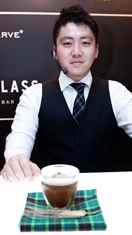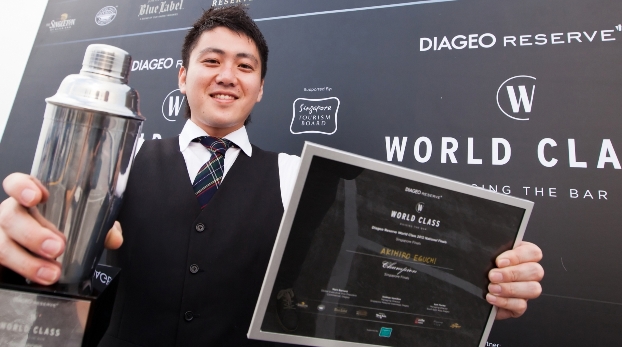Akihiro is a two times award winning bartender in the Singapore Diageo Reserve World Class competition. Akihiro believes that a perfect cocktail is not only about the balance of flavour in the drink, but also the right pairing of ice. Waku Ghin uses four different shapes of ice: square, iceball, diamond and crushed, with the first three all hand carved. Here, Akihiro works closely with Chef Tetsuya Wakuda – one who loves classic cocktails, in the pairings on their menu.
We talk to Akihiro about his experience in the Diageo World Class 2012 final representing Singapore and what he has brought back from the competition.
1. Why did you become a bartender?
Watching other bartenders when I was a teenager, I used to think they had the coolest job, plus they got all the attention from the ladies! I decided to try my hand at it when I was 20 years old, and have not looked back since.
2. Why have you moved to Singapore?
I moved here seven years ago to improve my skills as a bartender.
3. Tell us about your bartending journey in Japan. What is the biggest bar culture difference between Japan and Singapore?
I was born and raised in Yokohama. I trained in the art of Japanese-style cocktail making prior to coming to Singapore but then honed my skills here working at a Japanese Bar along Orchard Road. I then moved to Orgo at The Esplanade where I was bar manager, and finally, to Waku Ghin in October of 2011.
When I first arrived in Singapore, the local cocktail culture had really not developed yet. It really only exploded in the last couple of years- that was the biggest thing I noticed. Now it’s extremely exciting to see people so interested in the art of creating and savouring cocktails, and I feel that this in turn inspires bartenders like myself to note only create cocktails to satisfy customers but also showcase the art of cocktail making in the process.
4. What is your role in Marina Bay Sands Singapore?
I am currently the Head Bartender at Waku Ghin by Chef Tetsuya Wakuda.
5. What inspired you in the creation of your champion drink “Indulge In The Sky” in Diageo World Class Singapore 2012?
 I have always been a lover of Talisker whiskey and wanted to create an edgy, malty cocktail with it - something different. The dark chocolate infused into the cocktail really gives it a rich bitterness.
I have always been a lover of Talisker whiskey and wanted to create an edgy, malty cocktail with it - something different. The dark chocolate infused into the cocktail really gives it a rich bitterness.
6. What was the biggest challenge while going through the Diageo World Class Singapore 6 months program?
The biggest challenge was the Wine and Spirit Education Trust written exam. It is quite technical and having to do the written exam in English made it even more difficult.
7. Tell us the most rewarding thing which you have learned during the 5-day Global Finals in Rio de Janeiro.
I think the biggest thing would be to maintain flexibility in terms of what you are making. Even though we were able to plan what we wanted to make, sometimes, ingredients were not always readily available, forcing you to improvise. In addition, another lesson learnt was maintaining a sense of calmness under pressure.
8. Tell us more about the signature drink you created to compete in the Diageo World Class Global Final.
Throughout the competition, we had to create several signature drinks, but my favourite this time round was one that was inspired by Singapore - Little Red Dot*. I used Tanqueray 10 gin, fresh raspberries, lychee liqueur and Indian rosewater. The cocktail was a really pretty red colour, in line with my Singapore theme.
9. Are you participating in any more competitions after Diageo World Class?
I don’t have any plan for the moment. I feel blessed to have been able to participate in Diageo two years in a row, but I think for the immediate future, I just want to focus on improving my skills behind the bar at Waku Ghin.
10. What is your next goal in this bartending career?
I aspire to open my own cocktail and champagne bar someday.
*Little Red Dot is a byname for Singapore. The first time it was used by the Indonesian President Bacharuddin Jusuf Habibie while referring to the size of Singapore compared to Indonesia on the map. Political issues involving the economic crisis from year 1997 has struck a more frequent use of the epithet by politicians in both the countries. Ever since then, “Little Red Dot” has become a name used to refer to Singapore’s success despite its physical limitations.

Subscribe To The Newsletter